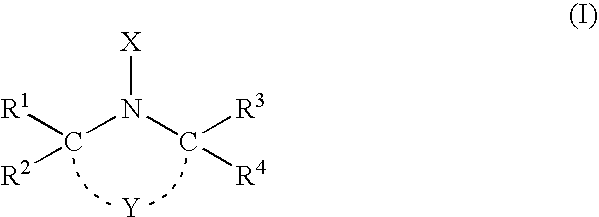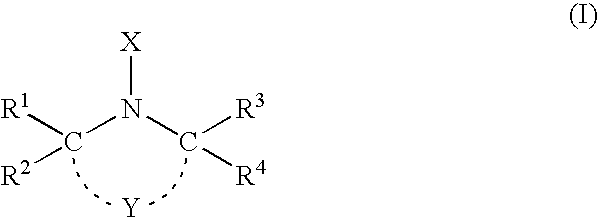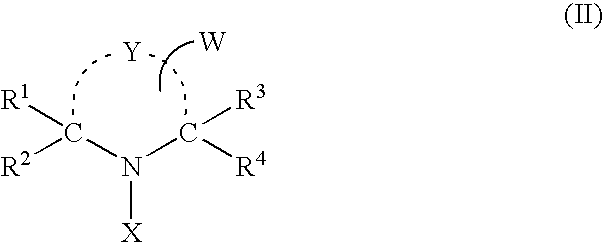However, in any ink jet recording method, ink droplets must be continuously and stably ejected from a fine nozzle.
However, such an aqueous ink comprises photosensitive optical deterioration-initiating factors incorporated in the colorant or
solvent constituting the ink and thus is
disadvantage in that the colorant undergoes photo-oxidation and hence so-called photo-deterioration such as discoloration.
Accordingly, the prints obtained by ink jet recording with such an ink exhibit a deteriorated light-resistance and thus is disadvantageous in that they are subject to disappearance of recorded letters or discoloration of recorded images in a relatively short period of time even when posted on the wall or under any other ordinary conditions.
Although the foregoing aqueous recording solution for ink jet recording, even if it comprises foregoing specific compound effective as a light-resistance improver, can provide prints no letter and / or images having improved properties, it is disadvantageous in that it is subject to disappearance of recorded letters or discoloration of recorded images in a long range.
The foregoing aqueous recording solution for ink jet recording also exhibits a deteriorated print quality, storage stability and reliability in ejection and a low reliability and thus can clog the nozzle particularly during ink jet recording.
The foregoing aqueous recording solution for ink jet recording also exhibits a low liquid stability and a deteriorated storage stability and thus can clog the nozzle during ink jet recording.
In the latter case, on the other hand, the entrance of bubbles due to destruction of ink
meniscus in the nozzle portion can be a main cause.
The cause of destruction of ink
meniscus can be
impact or scanning by the printing head.
However, such an ink having an enhanced
surface tension and
impact resistance penetrates into the recording medium at a reduced rate, occasionally exerting fatal effects on
image quality, e.g., deteriorated print quality such as blurred profile in
color image.
As a result, it was found that the reason why the aqueous recording solution for ink jet recording described in the above cited publication (see paragraphs , and ) exhibits deteriorated storage stability, reliability in ejection and print quality and clogs nozzle is attributed to the fact that it is quite free of low volatility component.
However, it was also found that such a low volatility component, if used excessively, produces much radicals, lessening the light-resistance which has been attained with much efforts.
As a result, it was found that the recording solution having an excellent light-resistance described in the above cited publication (see paragraphs , and ) exhibits a low liquid stability and a deteriorated storage stability and causes
nozzle clogging during ink jet recording is attributed to the metals and
metal ions contained as impurities in the specific compound.
When the content of the foregoing water-soluble
organic solvent falls below 5% by weight, the resulting aqueous ink exhibits deteriorated storage stability and ejection stability, making it impossible to prevent the clogging of nozzle.
On the contrary, when the content of the foregoing water-soluble organic
solvent exceeds 35% by weight, the resulting aqueous ink has a source of radicals causing the photo-oxidation reaction of the colorant present therein in a large amount, making it impossible to sufficiently enhance the light-resistance thereof even if a compound represented by the foregoing general formula (I) is incorporated therein.
Thus, prints obtained with the resulting ink exhibit deteriorated light-resistance and thus are subject to disappearance of recorded letters or discoloration of recorded image with time.
In particular, when used as an ink for ink jet recording, such an aqueous ink can clog the nozzle with precipitate.
When the content of the foregoing colorant falls below 0.1% by weight, the resulting print density is insufficient.
On the contrary, when the content of the foregoing colorant exceeds 20% by weight, the resulting aqueous ink can be subject to disadvantages such as increase of ink
viscosity and increase of possibility of clogging.
When the content or the foregoing
viscosity modifier exceeds 20% by weight, it is likely that the effect of inhibiting the photo-deterioration or ink by the compound represented by the foregoing general formula (I) can be lessened, making it impossible to provide prints with an excellent light-resistance.
When the content of the foregoing colorant falls below 0.1% by weight, the resulting print density is insufficient.
On the contrary, when the content of the foregoing colorant exceeds 20% by weight, the resulting aqueous ink can be subject to disadvantages such as increase of ink
viscosity and increase of possibility of clogging.
When the total content of metals and
metal ions contained in the compound represented by the foregoing general formulas (I) exceeds the foregoing value, the resulting aqueous ink exhibits a deteriorated liquid stability and thus can cause
precipitation during the storage of the ink.
In particular, when used as an ink for ink jet recording, the aqueous ink can cause clogging of nozzle.
However, bubbles which have entered in the ink passage can be extremely difficulty discharged even when subjected to
recovery by suction (cleaning).
As a result, once the print stability has been impaired, the print quality can be hardly recovered.
 Login to View More
Login to View More 


